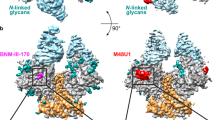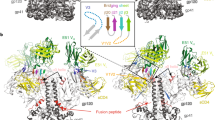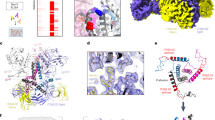Abstract
The refined solution structure of an 18-residue HIV-1IIIB V3 peptide in complex with the Fv fragment of an anti-gp120 antibody reveals an unexpected type VI β-turn comprising residues RGPG at the center of a β-hairpin. The central glycine and proline of this turn are linked by a cis peptide bond. The residues of the turn interact extensively with the antibody Fv. 15N{1H} NOE measurements show that the backbone of the peptide, including the central QRGPGR loop, is well ordered in the complex. The solution structure is significantly different from the X-ray structures of HIV-1MN V3 peptides bound to anti-peptide antibodies. These differences could be due to a two-residue (QR) insertion preceding the GPGR sequence in the HIV-1IIIB strain, and the much longer peptide epitope immobilized by the anti-gp120 antibody.
This is a preview of subscription content, access via your institution
Access options
Subscribe to this journal
Receive 12 print issues and online access
$189.00 per year
only $15.75 per issue
Buy this article
- Purchase on Springer Link
- Instant access to full article PDF
Prices may be subject to local taxes which are calculated during checkout




Similar content being viewed by others
Accession codes
References
Moore, J. & Trkola, A. AIDS Res. Hum. Retrovir. 13, 733–736 (1997).
Wu, L. et al. Nature 384, 179–183 (1996).
Trkola, A. et al. Nature 384, 184–187 (1996).
Hwang, S.S., Boyle, T.J., Lyerly, H.K. & Cullen, B.R. Science 257, 535–537 (1992).
Schreiber, M. et al. Clin. Exp. Immunol. 107, 15–20 (1997).
Honda, M. et al. Proc. Natl. Acad. Sci. USA 92, 10693–10697 (1995).
Hamajima, K. et al. Clin. Immunol. Immunopathol. 77, 374–379 (1995).
Rini, J.M. et al. Proc. Natl. Acad. Sci. USA 90, 6325–6329 (1993).
Ghiara, J.B., Stura, E.A., Stanfield, R.L., Profy, A.T. & Wilson, I.A. Science 264, 82–85 (1994).
Kwong P.D. et al. Nature 393, 648–659 (1998).
Matsushita, S. et al. J. Virol. 62, 2107–2114 (1988).
Emini, E. A. et al. Nature 355, 728–730 (1992).
Zvi, A. et al. Eur. J. Biochem. 229, 178–187 (1995).
Zvi, A., Feigelson, D.J., Hayek,Y. & Anglister, J. Biochemistry 36, 8619–8627 (1997).
Otting, G. & Wüthrich, K. Quart. Rev. Biophys. 23, 39 (1990).
Lipari, G. & Szabo, A. J. Am. Chem. Soc. 104, 4546–4568 (1982).
Weliky, D.P. et al. Nature Struct. Biol. 6, 141–145 (1999).
Zvi, A., Hiller, R. & Anglister, J. Biochemistry 31, 6972–6980 (1992).
LaRosa, G.J. et al. Science 249, 932–935 (1990).
Johnson, M.E., Lin, Z., Padmanabhan, K. & Kahn, M. FEBS Lett. 3, 4–8 (1994).
Endrich M.M. & Gehring, H. Eur. J. Biochem. 252, 441–446 (1998).
Sherry, B. et al. Proc. Natl. Acad. Sci. USA 95, 1758–63 (1998).
Faiman, G., Levy, R., Anglister, J. & Horovitz, A. J. Biol. Chem. 271, 13829–13833 (1996).
Tugarinov, V., Levy, R., Dahan-Shokoroy, A. & Anglister, J. J. Biomol. NMR, 13, 193–194 (1999).
Ikura, M. & Bax, A. J. Am. Chem. Soc. 114, 2433–2440 (1992).
Bax, A., Grzesiek, S., Gronenborn, A.M. & Clore, G.M. J. Magn. Res. Series A 106, 269–273 (1994).
Vuister, G.W., Kim, S.G., Wu, C. & Bax, A. J. Am. Chem. Soc. 116, 9206–9210 (1994).
Bodenhausen, G. & Ruben, D.J. Chem. Phys. Letters 69, 185–188 (1980).
Marion, D., Kay, L.E., Sparks, S.W., Torchia, D.A. & Bax, A. J. Am. Chem. Soc. 111, 1515–1517 (1989).
Fesik, S.W. & Zuiderweg, E.R.P., J. Magn. Reson. 78, 588–593 (1988).
Grzesiek, S. & Bax, A. J. Am. Chem. Soc. 115, 12593–12594 (1993).
Vuister, G.W. & Bax, A. J. Am. Chem. Soc. 115, 7772–7777 (1993).
Kuboniwa, H., Grzesiek, S., Delaglio, F. & Bax, A. J. Biomol. NMR 4, 871–878 (1994).
Kay, L.E., Nicholson, L.K., Delaglio, F., Bax, A. & Torchia, D.A. J. Magn. Reson. 97, 359–375 (1992).
Nilges, M., Clore, M. & Gronenborn, A. FEBS Lett. 229, 317–324 (1988).
Brünger, A.T. X-PLOR Version 3.1. A System for X-ray Crystallography & NMR (Yale University Press, New Haven, Connecticut; 1993).
Laskowsky, R.A., MacArthur, M.W., Moss, D.S. & Thornton, J.M. J. Appl. Crystallogr. 26, 283–291 (1993).
Koradi, R., Billeter, M. & Wüthrich, K. J. Mol. Graphics 14, 51–55 (1996).
Clore, G.M. et al. J. Am. Chem. Soc. 112, 4989–4991 (1993).
Acknowledgements
We thank F. Delaglio (NIH, Bethesda, USA) for NMR processing software, A. Bax (NIH, Bethesda, USA) and S. Grzesiek (Jülich Research Center, Germany) for pulse sequences and continuous assistance in the project. We are indebted to S. Matsushita (Kumamoto University, Japan) for the 0.5β hybridoma cells, and to A. Kapitkovsky and Y. Hayek (Weizmann Institute) for peptide synthesis and purification. G. Faiman and A. Horovitz (Weizmann Institute) are acknowledged for the joint effort to establish the Fv expression system. This research was supported by an NIH grant and the Minerva Foundation.
Author information
Authors and Affiliations
Corresponding author
Rights and permissions
About this article
Cite this article
Tugarinov, V., Zvi, A., Levy, R. et al. A cis proline turn linking two β-hairpin strands in the solution structure of an antibody-bound HIV-1IIIB V3 peptide. Nat Struct Mol Biol 6, 331–335 (1999). https://doi.org/10.1038/7567
Received:
Accepted:
Issue Date:
DOI: https://doi.org/10.1038/7567
This article is cited by
-
MOIRAE: A computational strategy to extract and represent structural information from experimental protein templates
Soft Computing (2014)
-
Structure and immune recognition of trimeric pre-fusion HIV-1 Env
Nature (2014)
-
Development of small molecules designed to modulate protein–protein interactions
Journal of Computer-Aided Molecular Design (2006)



